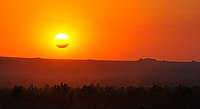
Photo from wikipedia
Abstract Since buildings consume a large portion of electricity worldwide, several technologies have been under research to reduce their energy demand and the carbon footprint. Semi-transparent photovoltaics (STPV) which transmits… Click to show full abstract
Abstract Since buildings consume a large portion of electricity worldwide, several technologies have been under research to reduce their energy demand and the carbon footprint. Semi-transparent photovoltaics (STPV) which transmits visible light yet, at the same time, produces electricity has most likely the highest potential to achieve this goal. The purpose of this paper is to find whether STPV – at its fundamental limit – can achieve net-zero energy building. We consider silicon based non-wavelength selective STPV and develop thermodynamic models for electrical, optical and thermal parameters. Based on this model, we estimate yearly net energy footprint of an office building for various climatic conditions. Building energy simulation is performed using EnergyPlus, combined with power generation calculation from a solar irradiance model. Our results suggest that for 50% visible transmittance, STPV on clear glass saves about 50% and 30% of the energy demand in tropical and hot desert regions respectively and around 20%–25% in Scandinavian and cold continental regions. When combined with a low-emissivity glass, the net saving reaches as high as 90% in tropical regions, 60% in hot desert regions and 45%–70% in the rest of the regions. We propose device and system level figures of merit that take into account usage of natural light as well as overall energy saving. The figures of merit capture the trade-offs between efficiency, solar heat gain and transparency and predict a much lower optimum transparency for places with abundant sunlight. We show that the low net saving for these hot regions can be improved to nearly 100% if such optimization strategies are adopted. This makes STPV, combined with low-emissivity glass, a promising technology across the globe.
Journal Title: Applied Energy
Year Published: 2020
Link to full text (if available)
Share on Social Media: Sign Up to like & get
recommendations!